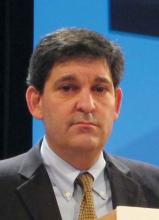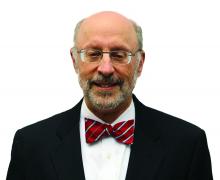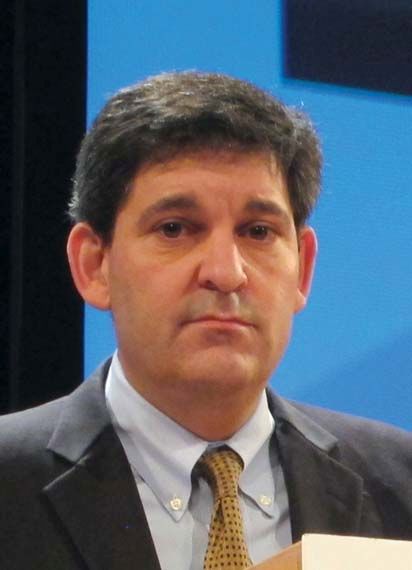User login
ORLANDO – Clinicians shouldn't let the lack of research on osteoporosis treatment compliance and barriers to care keep them from acting on what's already known about drug therapies' effectiveness in preventing fractures.
That's the advice from leaders at the American Society for Bone and Mineral Research, who discussed recent recommendations issued from a National Institutes of Health Pathways to Prevention Workshop on the “Appropriate Use of Drug Therapies for Osteoporotic Fracture Prevention.”
Speakers at a special session of the annual meeting were in agreement on the need for more research into current barriers of osteoporosis care and new methods for increasing patient and physician compliance with recommendations.
But the focus should also be on what researchers in bone health have already learned about treating osteoporosis, “which is quite a bit,” said Benjamin Z. Leder, MD, of Massachusetts General Hospital and Harvard Medical School, both in Boston, who gave the ASBMR’s perspective at the session. Dr. Leder was also first author on a perspective paper that outlined the society’s concerns about the recommendations coming from the workshop (J Bone Miner Res. 2019;34[9]:1549-51).
Gaps in knowledge and treatment
“We thought that [not focusing on what is already known about osteoporosis treatment] perhaps would have the potential to exacerbate the treatment gap that exists in osteoporosis therapy,” Dr. Leder said in his presentation. “We also felt that any knowledge deficits must be understood in the context of what has been unequivocally demonstrated in terms of our knowledge of osteoporosis therapies.”
That includes knowing how to identify patients at the highest risk of fracture, which medications reduce the risk of osteoporotic and osteopenic fractures, and that using these medications saves lives, Dr. Leder noted.
With limited resources in osteoporosis and the absence of any large, randomized, controlled trials or new therapies because of lack of interest from industry, stakeholders should be examining what can be done outside of trials. In osteoporosis, as is the case with any other therapeutic area or disease state, the results of randomized, placebo-controlled trials will not address every patient subgroup of interest, he said.
“Some extrapolation is always required,” Dr. Leder said. “We have to – as we treat, as we practice medicine – use the evidence we have and then try to use that to guide us when the randomized, controlled trial doesn’t answer that specific question.”
Dr. Leder also emphasized that fear of side effects such as osteonecrosis of the jaw and atypical femoral fracture are not the only barriers in osteoporosis care. Adherence is generally poor with osteoporosis treatment, and physicians usually have competing priorities when seeing their patients. “Even in the absence of the idea that these side effects are potentially paralyzing patients and physicians, we have to remember that we started from a fairly low baseline,” Dr. Leder said.
Other issues that complicate the issue of osteoporosis care are misinformation available online that may cause patients to not use medications, overestimations of the benefits of not using osteoporosis medication in favor of nondrug interventions, and conflicting, faulty, or unhelpful guidelines from medical societies, he said.
“There are a lot of issues that need to be addressed. The [Pathways to Prevention] has really done us a great service, and the ASBMR hopes to continue supporting their efforts moving forward,” he said.
Recommendations for secondary fracture prevention
Although there are gaps in osteoporosis treatment, there is still room to act, which the ASBMR aimed to accomplish in its Secondary Fracture Prevention Initiative, Douglas P. Kiel, MD, MPH, said in his presentation.
In 2016, the ASBMR put out a Call to Action to intensify screening for high-risk patients to prevent fractures, and 39 organizations signed on to the effort. The target population for the initiative is men and women aged 65 years or older who have experienced a vertebral or hip fracture who would ideally be appropriately evaluated, managed, and treated in a multidisciplinary clinical system with case management through systems like a fracture liaison service.
“The bottom line is, if you have a patient in this age group who has already experienced one of these fractures, they should be treated,” said Dr. Kiel, director of the Musculoskeletal Research Center at the Institute for Aging Research at Hebrew SeniorLife in Boston and a professor of medicine at Harvard Medical School. “It doesn’t mean we should ignore other populations, but we need to start somewhere, and this was a well-defined, at-risk population.”
Consensus clinical recommendations for the initiative were recently published in the Journal of Bone and Mineral Research (J Bone Miner Res. 2019 Sep 20. doi: 10.1002/jbmr.3877), and the ASBMR plans to spread the recommendations in a wide number of areas, including through stakeholder organizations, social media, webinars, educational sessions, and in other guidelines.
The next step for the initiative is to execute the ASBMR’s Action Plan, which prioritizes challenges such as reimbursement for fracture liaison services and care coordination, establishment of a national fracture registry, and sharing the society’s messaging on osteoporosis fracture–prevention in guidelines and education services. The ASBMR is also examining whether it could take advantage of a new National Institutes of Health grant for dissemination and implementation research in health to help fund the Secondary Fracture Prevention Initiative, Dr. Kiel said.
Dr. Leder and Dr. Kiel reported no relevant financial disclosures.
ORLANDO – Clinicians shouldn't let the lack of research on osteoporosis treatment compliance and barriers to care keep them from acting on what's already known about drug therapies' effectiveness in preventing fractures.
That's the advice from leaders at the American Society for Bone and Mineral Research, who discussed recent recommendations issued from a National Institutes of Health Pathways to Prevention Workshop on the “Appropriate Use of Drug Therapies for Osteoporotic Fracture Prevention.”
Speakers at a special session of the annual meeting were in agreement on the need for more research into current barriers of osteoporosis care and new methods for increasing patient and physician compliance with recommendations.
But the focus should also be on what researchers in bone health have already learned about treating osteoporosis, “which is quite a bit,” said Benjamin Z. Leder, MD, of Massachusetts General Hospital and Harvard Medical School, both in Boston, who gave the ASBMR’s perspective at the session. Dr. Leder was also first author on a perspective paper that outlined the society’s concerns about the recommendations coming from the workshop (J Bone Miner Res. 2019;34[9]:1549-51).
Gaps in knowledge and treatment
“We thought that [not focusing on what is already known about osteoporosis treatment] perhaps would have the potential to exacerbate the treatment gap that exists in osteoporosis therapy,” Dr. Leder said in his presentation. “We also felt that any knowledge deficits must be understood in the context of what has been unequivocally demonstrated in terms of our knowledge of osteoporosis therapies.”
That includes knowing how to identify patients at the highest risk of fracture, which medications reduce the risk of osteoporotic and osteopenic fractures, and that using these medications saves lives, Dr. Leder noted.
With limited resources in osteoporosis and the absence of any large, randomized, controlled trials or new therapies because of lack of interest from industry, stakeholders should be examining what can be done outside of trials. In osteoporosis, as is the case with any other therapeutic area or disease state, the results of randomized, placebo-controlled trials will not address every patient subgroup of interest, he said.
“Some extrapolation is always required,” Dr. Leder said. “We have to – as we treat, as we practice medicine – use the evidence we have and then try to use that to guide us when the randomized, controlled trial doesn’t answer that specific question.”
Dr. Leder also emphasized that fear of side effects such as osteonecrosis of the jaw and atypical femoral fracture are not the only barriers in osteoporosis care. Adherence is generally poor with osteoporosis treatment, and physicians usually have competing priorities when seeing their patients. “Even in the absence of the idea that these side effects are potentially paralyzing patients and physicians, we have to remember that we started from a fairly low baseline,” Dr. Leder said.
Other issues that complicate the issue of osteoporosis care are misinformation available online that may cause patients to not use medications, overestimations of the benefits of not using osteoporosis medication in favor of nondrug interventions, and conflicting, faulty, or unhelpful guidelines from medical societies, he said.
“There are a lot of issues that need to be addressed. The [Pathways to Prevention] has really done us a great service, and the ASBMR hopes to continue supporting their efforts moving forward,” he said.
Recommendations for secondary fracture prevention
Although there are gaps in osteoporosis treatment, there is still room to act, which the ASBMR aimed to accomplish in its Secondary Fracture Prevention Initiative, Douglas P. Kiel, MD, MPH, said in his presentation.
In 2016, the ASBMR put out a Call to Action to intensify screening for high-risk patients to prevent fractures, and 39 organizations signed on to the effort. The target population for the initiative is men and women aged 65 years or older who have experienced a vertebral or hip fracture who would ideally be appropriately evaluated, managed, and treated in a multidisciplinary clinical system with case management through systems like a fracture liaison service.
“The bottom line is, if you have a patient in this age group who has already experienced one of these fractures, they should be treated,” said Dr. Kiel, director of the Musculoskeletal Research Center at the Institute for Aging Research at Hebrew SeniorLife in Boston and a professor of medicine at Harvard Medical School. “It doesn’t mean we should ignore other populations, but we need to start somewhere, and this was a well-defined, at-risk population.”
Consensus clinical recommendations for the initiative were recently published in the Journal of Bone and Mineral Research (J Bone Miner Res. 2019 Sep 20. doi: 10.1002/jbmr.3877), and the ASBMR plans to spread the recommendations in a wide number of areas, including through stakeholder organizations, social media, webinars, educational sessions, and in other guidelines.
The next step for the initiative is to execute the ASBMR’s Action Plan, which prioritizes challenges such as reimbursement for fracture liaison services and care coordination, establishment of a national fracture registry, and sharing the society’s messaging on osteoporosis fracture–prevention in guidelines and education services. The ASBMR is also examining whether it could take advantage of a new National Institutes of Health grant for dissemination and implementation research in health to help fund the Secondary Fracture Prevention Initiative, Dr. Kiel said.
Dr. Leder and Dr. Kiel reported no relevant financial disclosures.
ORLANDO – Clinicians shouldn't let the lack of research on osteoporosis treatment compliance and barriers to care keep them from acting on what's already known about drug therapies' effectiveness in preventing fractures.
That's the advice from leaders at the American Society for Bone and Mineral Research, who discussed recent recommendations issued from a National Institutes of Health Pathways to Prevention Workshop on the “Appropriate Use of Drug Therapies for Osteoporotic Fracture Prevention.”
Speakers at a special session of the annual meeting were in agreement on the need for more research into current barriers of osteoporosis care and new methods for increasing patient and physician compliance with recommendations.
But the focus should also be on what researchers in bone health have already learned about treating osteoporosis, “which is quite a bit,” said Benjamin Z. Leder, MD, of Massachusetts General Hospital and Harvard Medical School, both in Boston, who gave the ASBMR’s perspective at the session. Dr. Leder was also first author on a perspective paper that outlined the society’s concerns about the recommendations coming from the workshop (J Bone Miner Res. 2019;34[9]:1549-51).
Gaps in knowledge and treatment
“We thought that [not focusing on what is already known about osteoporosis treatment] perhaps would have the potential to exacerbate the treatment gap that exists in osteoporosis therapy,” Dr. Leder said in his presentation. “We also felt that any knowledge deficits must be understood in the context of what has been unequivocally demonstrated in terms of our knowledge of osteoporosis therapies.”
That includes knowing how to identify patients at the highest risk of fracture, which medications reduce the risk of osteoporotic and osteopenic fractures, and that using these medications saves lives, Dr. Leder noted.
With limited resources in osteoporosis and the absence of any large, randomized, controlled trials or new therapies because of lack of interest from industry, stakeholders should be examining what can be done outside of trials. In osteoporosis, as is the case with any other therapeutic area or disease state, the results of randomized, placebo-controlled trials will not address every patient subgroup of interest, he said.
“Some extrapolation is always required,” Dr. Leder said. “We have to – as we treat, as we practice medicine – use the evidence we have and then try to use that to guide us when the randomized, controlled trial doesn’t answer that specific question.”
Dr. Leder also emphasized that fear of side effects such as osteonecrosis of the jaw and atypical femoral fracture are not the only barriers in osteoporosis care. Adherence is generally poor with osteoporosis treatment, and physicians usually have competing priorities when seeing their patients. “Even in the absence of the idea that these side effects are potentially paralyzing patients and physicians, we have to remember that we started from a fairly low baseline,” Dr. Leder said.
Other issues that complicate the issue of osteoporosis care are misinformation available online that may cause patients to not use medications, overestimations of the benefits of not using osteoporosis medication in favor of nondrug interventions, and conflicting, faulty, or unhelpful guidelines from medical societies, he said.
“There are a lot of issues that need to be addressed. The [Pathways to Prevention] has really done us a great service, and the ASBMR hopes to continue supporting their efforts moving forward,” he said.
Recommendations for secondary fracture prevention
Although there are gaps in osteoporosis treatment, there is still room to act, which the ASBMR aimed to accomplish in its Secondary Fracture Prevention Initiative, Douglas P. Kiel, MD, MPH, said in his presentation.
In 2016, the ASBMR put out a Call to Action to intensify screening for high-risk patients to prevent fractures, and 39 organizations signed on to the effort. The target population for the initiative is men and women aged 65 years or older who have experienced a vertebral or hip fracture who would ideally be appropriately evaluated, managed, and treated in a multidisciplinary clinical system with case management through systems like a fracture liaison service.
“The bottom line is, if you have a patient in this age group who has already experienced one of these fractures, they should be treated,” said Dr. Kiel, director of the Musculoskeletal Research Center at the Institute for Aging Research at Hebrew SeniorLife in Boston and a professor of medicine at Harvard Medical School. “It doesn’t mean we should ignore other populations, but we need to start somewhere, and this was a well-defined, at-risk population.”
Consensus clinical recommendations for the initiative were recently published in the Journal of Bone and Mineral Research (J Bone Miner Res. 2019 Sep 20. doi: 10.1002/jbmr.3877), and the ASBMR plans to spread the recommendations in a wide number of areas, including through stakeholder organizations, social media, webinars, educational sessions, and in other guidelines.
The next step for the initiative is to execute the ASBMR’s Action Plan, which prioritizes challenges such as reimbursement for fracture liaison services and care coordination, establishment of a national fracture registry, and sharing the society’s messaging on osteoporosis fracture–prevention in guidelines and education services. The ASBMR is also examining whether it could take advantage of a new National Institutes of Health grant for dissemination and implementation research in health to help fund the Secondary Fracture Prevention Initiative, Dr. Kiel said.
Dr. Leder and Dr. Kiel reported no relevant financial disclosures.
EXPERT ANALYSIS FROM ASBMR 2019


